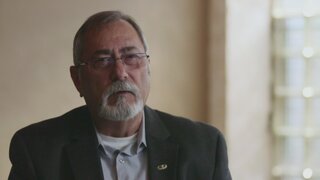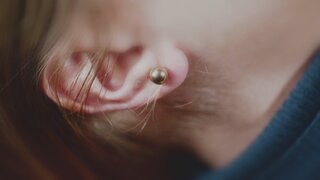Create a free profile to get unlimited access to exclusive videos, breaking news, sweepstakes, and more!
'Dating Game Killer' Rodney Alcala May Have Strangled And Murdered Around 100 Women
Serial killer Rodney Alcala, whose total victim count is unknown, posed as a fashion photographer to gain access to young women.
Murders A-Z is a collection of true crime stories that take an in-depth look at both little-known and famous murders throughout history.
Under the seemingly widespread fascination with serial killers is the fear that they are the person next door: someone with bloodlust under a veneer of normalcy. While some serial killers are damaged outsider figures, others “pass,” including Ted Bundy (worked in politics) and Dennis Rader (church-going father).
Add Rodney Alcala to the list.
Alcala was a hip and handsome fashion photographer who once wona dating game show in the ‘70s – although the woman who chose him in the game show didn’t end up wanting to go on the date with him because she thought he was too creepy.
In the reality, Alcala is a child molester, rapist and murderer, whose final victim tally remains unknown. (The police estimate that he may have killed dozens of women, with some estimates running as high as 130, reports the Rolling Stone.)
Rodney Alcala was born Rodrigo Jacques Alcala Buquor in San Antonio, Texas, in 1943. His father abandoned the family when he was a boy, according to CBS’ “48 Hours.” He later moved to Los Angeles, where he grew up with his mother and two sisters.
Enlisting in the United States Army at 17, Alcala was discharged after suffering a nervous breakdown, as well as allegations of sexual misconduct, according to “48 Hours.” After leaving the Army, Alcala attended UCLA’s esteemed School of Theater, Film and Television and earned a Bachelor’s Degree, according to the Los Angeles Daily News.
In 1968 Alcala saw 8-year old Tali Shapiro walking to school in Hollywood and offered her a ride in his car. “He goes, ‘I’m a friend of your parents,’ and I went, ‘Oh, okay,’” she later recalled in testimony, as reported by Los Angeles’ KABC-TV.
Sensing something suspicious, a good Samaritan reported the incident to police, who went to Alcala’s apartment. When they knocked on his door, he stalled and ran out the back. Cops kicked down his door and found Shapiro naked and bloodied on the kitchen floor.
She had been raped and beaten unconscious with a metal bar.
Shapiro makes a rare appearance on “Mark of a Killer,” streaming now on Oxygen.com, to talk about her experience surviving the serial killer whose chosen method was repeated strangulation.
Alcala escaped immediate punishment.
He fled across the country, settling on the East Coast. Using an assumed name, he enrolled at New York University, studying film with controversial director Roman Polanski, reported Vice. He began approaching women and young boys, saying he was a fashion photographer and asking if they would pose for him.
One was a 23-year-old flight attendant named Cornelia Crilley. In 1971, she was found raped and murdered in her Manhattan apartment, a crime that wouldn’t be connected to Alcala until 40 years later, according to The New York Times.
The police would later release more than one hundred photos they found in Alcala’s storage unit in case the public recognized any of these women, according to NBC News. Twenty-one women were identified from these photographs, reported CBS News in late 2016.
Using the name John Berger, Alcala moved to New Hampshire soon after the Crilley murder and somehow found work as a counselor at an arts and drama camp for teenagers. Fortunately, it was not to last.
“Two girls went to their local post office and they looked and there was Rodney Alcala's photo on the FBI Ten Most Wanted list,” Orange County Deputy District Attorney Matt Murphy told “48 Hours.” “They looked up and said, ‘Oh my gosh, that's Mr. Berger.’”
Alcala was arrested for the Shapiro rape and convicted of a lesser charge of child molestation in 1972, according to the Pasadena Sun Times. He would serve less than three years in prison.
However, just months after his release he would be sent back to prison in 1974 on a parole violation after attempting to abduct a 13-year-old girl, according to the LA Weekly. He would spend the next two years in prison.
Upon his release from prison in 1977, Alcala talked his parole officer into allowing him to travel to New York City, despite being a registered sex offender. While there, he murdered Ellen Jane Hover, 23. In a 2013 opinion piece in The New York Times, her cousin Sheila Weller said on the day Hover disappeared she had an appointment to be photographed by a man named John Berger.
According to LA Weekly, police would eventually track Alcala down in California and question him about the case, but never charged him since Hover’s body still hadn’t been found. Her bones were discovered 11 months after her disappearance in Westchester County, New York.
Back in California, Alcala got a job as a typesetter with the Los Angeles Times and resumed his murderous ways. It would be decades before DNA evidence and Alcala’s own confessions revealed the extent of his crimes. His victims were found in both Southern and Northern California, and possibly as far away as Washington stateand Wyoming, where he was charged as recently as 2016 in the death of Christine Ruth Thornton, who was six months pregnant at the time of her death, according to the Orange County Register.
His victims were raped and brutally beaten before being strangled.
At the same time Alcala was claiming his own victims, the “Hillside Strangler” was monopolizing headlines and spreading fear throughout greater Los Angeles. In fact, Alcala’s rape and murder of 18-year-old Jill Barcomb in November 1977 was initially attributed to the Hillside Strangler in The Washington Post.
And while cousins Angelo Buono Jr. and Kenneth Bianchi were eventually convicted for the “Hillside Strangler” murders, as a registered sex offender in the Los Angeles area, Alcala was interviewed by the LAPD task force investigating the case. According to the LA Weekly, when questioned in March 1978, police arrested him for marijuana possession, for which he served a short sentence in county jail.
Later that year, Alcala earned his nickname when he appeared as a contestant on kitschy ‘70s game show, “The Dating Game,” in a bizarre moment where crime intersected with pop culture. Introduced as a “successful photographer” whose interests included skydiving and motorcycling, he would beat out the competition and was chosen by bachelorette Cheryl Bradshaw as her “dream date.”
Backstage, however, she declined the opportunity.
“I started to feel ill. He was acting really creepy,” Bradshaw was quoted in Britain’s Sunday Telegraph. “I turned down his offer. I didn't want to see him again.”
On June 20, 1979, 12-year-old Robin Samsoe of Huntington Beach, California was with a friend when Alcala approached them and asked if he could take their picture, according to KABC-TV.
When Samsoe left for ballet class, Alcala abducted and murdered her, leaving her body in Angeles National Forest, where it was picked over by wild animals and not found until 12 days later. Samsoe’s friend helped police craft a composite sketch, which was recognized by Alcala’s former probation officer, according to the Los Angeles Times.
Alcala was arrested at his mother’s house on July 24, 1979. He had no alibi for the day of Samsoe’s murder and while searching the home, police found a receipt for a storage locker in Seattle, Washington, according to “48 Hours.”
Two days later, detectives from the Huntington Beach Police Department went north and cracked it open. Inside they found a pair of earrings that belonged to Samsoe as well as hundreds of photographs of young women and children, many of them sexually explicit.
In 1980, Alcala was sentenced to nine years in prison for the 1979 rape of a 15-year-old girl, and months later given the death penalty after being found guilty in the Samsoe murder, according to the Los Angeles Times. Perhaps unbelievably, both his murder conviction and death sentence were overturned on appeals, in 1984 and 2001, respectively.
By the time of Alcala’s third murder trial in 2010, advances in forensic technology now tied him to the rape and murder of an additional four women in Los Angeles between 1977 and 1979. Alcala represented himself, and according to the Los Angeles Timesspent most of his time contesting the Samsoe case, ignoring the other four murders charges he was facing. That March, he was convicted and sentenced to death for the murders of Robin Samsoe, Jill Barcomb, Georgia Wixted, Charlotte Lamb, and Jill Parenteau, as reported by CBS News.
Alcala’s legal woes, however, weren’t over. In 2011, The New York Timesreported a grand jury in Manhattan had indicted Alcala for the murders of Cornelia Crilley and Ellen Jane Hover. Rather than fight the charges, Alcala pleaded guilty in 2012 and in January 2013 was sentenced to 25 years to life, according to Reuters. Now 75 and sitting on death row in California, it is assumed he will never serve his sentence in New York.
Rodney Alcala’s final victim count remains uncertain to this day.
Learn more about the violence of Alcala’s methods and other serial killers on “Mark of a Killer” on Oxygen.























